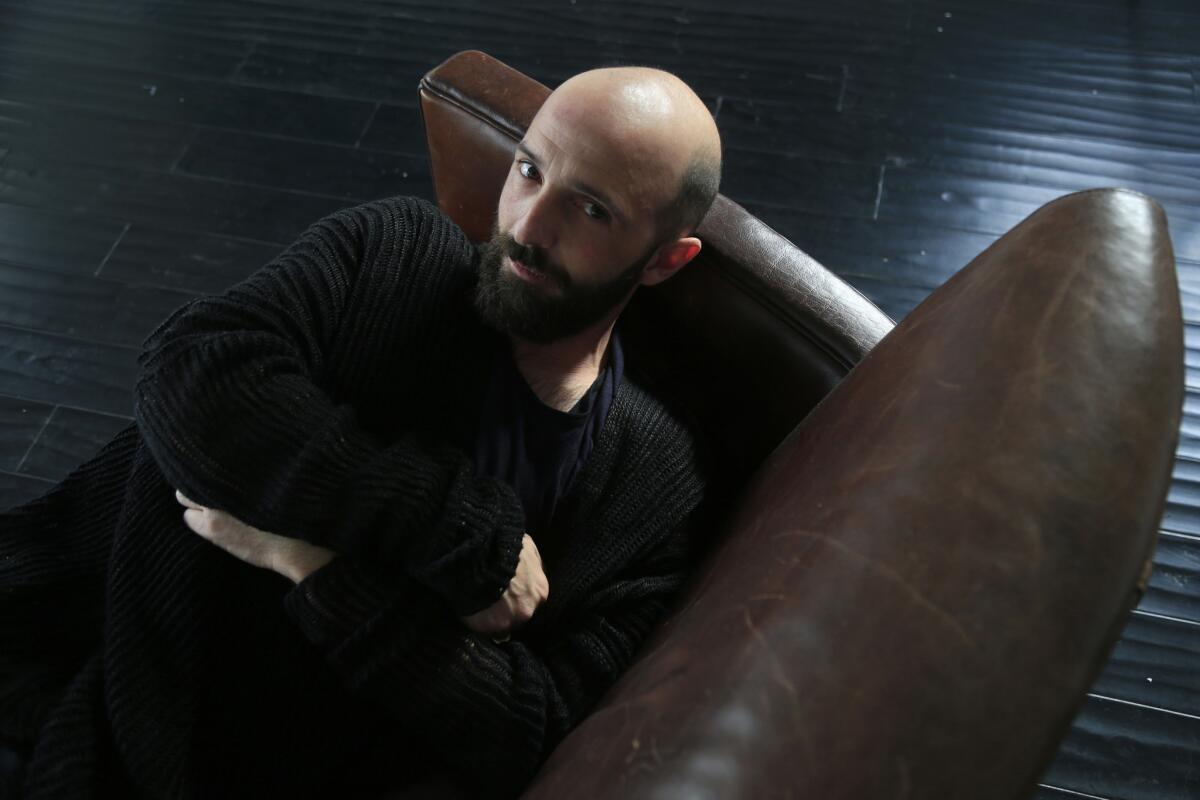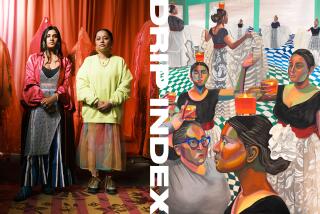Piero Goliaâs outlandish Chalet Hollywood, an art speakeasy

Chalet Hollywood was one of those places that was never meant to be easy to find. It didnât have a phone number or a website. It never showed up on Google Maps. And there was no sign. The only way to access it was through a dim parking lot off Hollywood Boulevard, where the only evidence of its existence might be the presence of a couple of slouchy hipsters grabbing a smoke on a loading dock.
Yet for roughly 14 months, this diminutive art speakeasy (less than 1,000 square feet in size) drew an impressive array of cultural figures to what was essentially a pair of old storage rooms at the rear of Los Angeles Contemporary Exhibitions in Hollywood. Artists, choreographers, museum directors, collectors, socialites and, at one point, a pair of alpacas, jammed into tight quarters where, on a given night, you might encounter a pianist, mariachis or a marching band.
âThe Chalet was a tool,â says artist Piero Golia, who masterminded the venture. âItâs a tool that you use to create community.â
Meticulously designed by architect Edwin Chan, this under-the-radar space, which drew its audience entirely by word of mouth, is now set to go public at the Nasher Sculpture Center in Dallas. All of the architectural elements from the Hollywood space have been dismantled and will be reassembled in the fall in a new design by Chan inside a Nasher gallery.
âIn Los Angeles, the Chalet was essentially open when Piero would have an event there,â says Nasher director Jeremy Strick, director of Los Angelesâ Museum of Contemporary Art for nine years before he moved to Dallas. âAt the Nasher, it will be a space during the daytime that regular museum visitors can walk into and see. But during certain evenings, when Piero animates it, it will have a very different life.â
Like many contemporary art projects, the Chalet eludes easy classification. With its inky blue walls, cork floors and geometric arrangements of sensuous white oak beams, the space was an impressive work of architecture.
There were other elements too: a canvas by L.A. painter Mark Grotjahn, a photograph by noted lensman Jeff Wall and an aquarium by French conceptualist Pierre Huyghe, whose work is on view at a Los Angeles County Museum of Art retrospective. Curated events brought the Chalet to life, making it as much a social club as an installation.
âIf you say, is it my piece of art?â Golia asks rhetorically, âI will say, âNo.â If you say is it an art experience? I will say, âYes.ââ
It takes a force of personality to make an art project based on socializing come to fruition. But personality is something Golia has in abundance. Born and raised in Naples, Italy, Golia is bearded and compact, with a cinematic Italian accent and a tattoo on his right arm that reads, âNo Regrets.â He charms with R-rated monologues about everything from stingy billionaires to bad design.
âL.A. in the â50s, â60s and â70s was a pioneer city of architecture,â he says during one such soliloquy at his temporary Hollywood Hills studio, which overlooks the Chateau Marmont. âBut now itâs a city that gives a building permit to anyone who complies with the code. They are building shamefully.â
Like the Chalet Hollywood project, Goliaâs art ideas have always had a certain outlandishness.
In 2001, he persuaded a stranger to get her back tattooed with an image of his face and the caption âPiero My Idol.â In 2008, he crushed a 35-foot-long bus to fit the dimensions of a booth at a Los Angeles art fair. Two years later, he created âLuminous Sphere,â a massive light-up globe on top of the Standard Hotel in West Hollywood. Any time the artist was in town, the light would come on. Among as-yet-unrealized projects, Golia would like to construct a border wall between L.A. and Orange County.
âHe gets an idea, and thatâs the big deal,â says Grotjahn, who lent Golia a painting for the Chalet. âAnd itâs Plan A until everything has been exhausted and then maybe you come up with a new plan.â
For the Chalet, Golia wanted to a club where everything would be free and where L.A. culturati could gather outside the well-trod circuit of art openings and often-dull patron dinners. His goal was to create a social space that had no goal.
âWhen you go to events in L.A., people make appearances,â he explains. âEverything happens according to a script. We wanted to break from the script.â
As co-conspirator, Golia enlisted Chan, who runs his own firm, EC3, in Venice, but for more than two decades was a senior design partner at Frank Gehryâs office, where he worked on some of Gehryâs most important art spaces, including the Guggenheim Museum in Bilbao, Spain, and the newly opened Fondation Louis Vuitton in Paris.
âPieroâs email [began], âI got this beautiful idea,ââ Chan says. âIt ended with, âWill you design it?ââ
Where Golia is live-the-moment flamboyant, Chan is methodical and cerebral. But he has an adventurous side and was immediately intrigued by Goliaâs concept.
âThis would be the anti-white cube,â Chan says. âA white-box space is not necessary to have an intimate artistic encounter.â
Golia, describing his vision, lets the full force of his personality come through: âI didnât want avant-garde.... At our first meeting, I showed [Edwin] pictures of Marie Antoinetteâs room. He hates me for this, but I wanted something that would combine art and architecture to create an experience, a very beautiful stage for the community to be.â
That beautiful stage ended up being the pair of storage rooms at LACE, the artist-founded exhibition space that sits right on the Hollywood Walk of Fame. In 2011, Golia persuaded then-director Carol Stakenas as well as the organizationâs board of directors to turn over use of the rooms for the duration of his project.
For Stakenas, the Chalet presented an opportunity to do something experimental with a couple of dreary storage rooms â one of which was affectionately known as the âRoom of Shameâ for its stockpile of old pedestals and broken technology.
âIt was highly social and conceptual,â she says. âAnd I think it asked the fundamental question: Where do we encounter a memorable art experience?â
Once the space was secured, Chan and Golia got to work transforming it. They punched a trapezoidal hole between the two storage rooms to link the spaces. They lined the walls with rich Venetian plaster in a sparkling shade of blue and laid cork on the floors so the rooms wouldnât echo. After a months-long hunt, they acquired 3,500 board feet of white oak from a stand of dead trees in Pennsylvania, which Chan arranged into angled patterns and geometric stacks around the space.
L.A. artist Christopher Williams supplied a piano once used at an art school in Dusseldorf, where it had allegedly been played by Joseph Beuys, the German artist who in the 1960s articulated the concept of âsocial sculptureâ â the idea that human activity could be art.
By September 2013, when Chalet Hollywood opened, the industrial cellblock architecture had been transformed into something that resembled a deconstructed Swiss chalet.
âIt was,â Stakenas says, âa little jewel of a space.â
To this art-and-architecture ensemble, Golia added people: artists, collectors, art assistants, writers such as Bret Easton Ellis and sundry museum directors, including LACMAâs Michael Govan and MOCAâs Philippe Vergne. There were also singers, film producers, socialites and party girls as well as Goliaâs plumber.
âWhat got you membership to the Chalet was wanting to go there enough to find out how to get in,â Golia says. âA lot of people started to show up that I donât even have their phone number.â
For the first event, he organized a performance by the L.A. Ladies Choir. Other evenings featured piano recitals, a magician and, in November 2013, a dance performed by choreographer Stephen Galloway, his first since departing the Frankfurt Ballet in 2004.
The UCLA marching band showed up to welcome Huyghe, who had just landed in Los Angeles to work on his LACMA retrospective. At another happening, art collector Stefan Simchowicz was spanked by a dominatrix.
Then there were the alpacas.
Golia had wanted to bring L.A.âs most glamorous couple to the Chalet. âPeople tell me, the most beautiful people, itâs Brad Pitt and Angelina Jolie,â he recalls. âI called all of my Hollywood friends and they said, âImpossible!â But my assistant, he said, âI got you the beautiful couple.ââ
Turns out there was an alpaca beauty contest in Hollywood, so for a night as guests sipped champagne, a pair of alpacas roamed the space.
These stunts were never announced in advance. Golia says it was important that the Chalet contain an element of surprise.
âFor me, it was important not to establish a standard,â explains Golia. ââPeople ask, âWhat will there be?â I say, âCome if you want to come or donât come.â
Of course, the free party didnât come cheap. The Chalet was a spare-no-expense epic, with frequent starts and stops as money came in and ran out. Plus, there was all the Veuve Clicquot champagne dispensed gratis to anyone who walked through the door.
âI really managed this in the Napoli way,â Golia says with a shrug. âI would get $10,000 [and] ask myself, âWhat can I get for $10,000? We probably spend double because we do things out of order.â
Golia estimates the entire project â materials, construction, musicians, champagne, alpacas â cost roughly $500,000.
Thatâs an extravagant sum for LACE, a small nonprofit whose annual budget about matches what Golia spent. But this wasnât a LACE exhibition. The Chalet operated as an autonomous project and was listed nowhere on the LACE website. LACE provided the space free of charge to Golia â but he had to fund construction, maintenance and events. He was also responsible for its management, from hiring bartenders to feeding the crabs in Huygheâs tank.
âIt cut new ground for us, certainly with the construction,â says Bill Moreno, chair of LACEâs board of directors. âBut from LACEâs standpoint, it energized a space that was a little woebegone.â
Golia says he raised roughly half the funds â $250,000 â from patrons and friends, including L.A. gallerist David Kordansky and Mexican juice magnate and MOCA trustee Eugenio Lopez. A 2013 Graham Foundation grant defrayed $10,000 in costs. The rest of the funds he supplied himself: about a quarter-million dollars. (Golia says heâs $100,000 in debt as a result.)
âIf you think numbers, the Chaletâs the most stupid thing ever done,â says Golia, who held his last Chalet party in November.
âBut if you think memories,â he adds, âitâs worth every penny.â
Twitter: @cmonstah
More to Read
The biggest entertainment stories
Get our big stories about Hollywood, film, television, music, arts, culture and more right in your inbox as soon as they publish.
You may occasionally receive promotional content from the Los Angeles Times.











